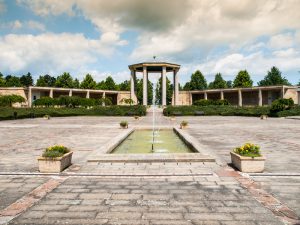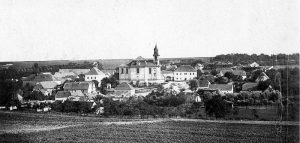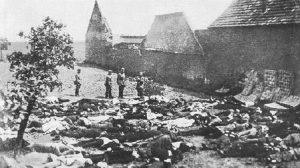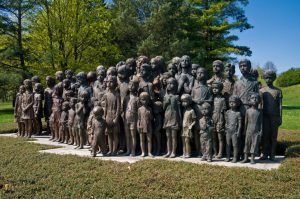Lidice and Ležáky
By Erin Naillon
The History of Lidice
 The village of Lidice, population 503 in 1942, had existed for hundreds of years; perhaps a thousand. The first written mention of the village dates from around 1300. It survived the Hussite Wars, as well as the Thirty Years’ War. For Lidice, as well as the village of Ležáky, the worst – by far – was yet to come.
The village of Lidice, population 503 in 1942, had existed for hundreds of years; perhaps a thousand. The first written mention of the village dates from around 1300. It survived the Hussite Wars, as well as the Thirty Years’ War. For Lidice, as well as the village of Ležáky, the worst – by far – was yet to come.
The Assassination of SS Reichsprotector Reinhard Heydrich
Following the assassination in Prague of SS Reichsprotector Reinhard Heydrich, a man so brutal even Heinrich Himmler was afraid of him; the Nazis made a brutal move. A man serving in the Czechoslovak army in Britain was from Lidice; his family, the Horáks, remained in the village. The Gestapo unit based in the city of Kladno became suspicious that the Horák family had something to do with Heydrich’s death. They searched the house and found no sign that the family had been involved in any way with the assassination, but the Nazis wanted blood, and they were determined to have it.
The Lidice Massacre
Very early in the morning of June 10, 1942, cameras shot silent footage of the events at Lidice. The Horák farm served as the execution ground for 173 males above the age of sixteen; all were shot to death. The women and children were taken to the gym of the elementary school in Kladno. Three days later, the children were taken from their mothers.
Ravensbruck and Chelmno
The women were sent to the Ravensbruck concentration camp. The children – the youngest a year and six days old – were sent to Lodz, Poland. There they lived for the next three weeks. Then, an order came that they were to be sent to the Chelmno death camp.
The Children of Lidice
The children were told to undress for a “shower” before the journey. In their underwear, holding soap and towels, they were loaded onto a truck that had been modified so that the exhaust fumes were sent into the back of the vehicle. Within eight minutes, the children in the truck were dead. There had been 105 children in Lidice. Seventeen survived the war. It took more than two years after the war’s end to find the final survivor and bring him home. Now that the village and its buildings were empty, the Nazis burned, then blew up the structures. They razed the church and desecrated the cemetery.
Lidice Lives on
It took little time for the news of the Lidice massacre to spread around the world. At least four towns worldwide are now named Lidice; so are many women born during and after that time. On June 10, 1945, a peace rally was held, attended by some of the women who had survived the massacre. Seventeen children survived. One hundred forty-three women came back to what was once home. In 1947, the Czech government began to rebuild Lidice. The new village rose approximately 150 meters from the former site. On June 19, 1955, a rose garden opened in the “Park of Peace and Friendship.”
The Nuremberg Trials and Beyond
At the Nuremberg Trials, the grim, silent footage of the mass murder was shown as Document Number 379. Some of the films are still shown at the Lidice Memorial today. A museum dedicated to the tragedy of Lidice opened in 1962; it is open most of the year, except December 24 – 26 and 31 and New Year’s Day. The cost is 80 Czech crowns for adults and 40 Czech crowns for children, students, and senior citizens.
Next target – the Village of Lezaky
Lidice didn’t suffer alone. After the Nazis had finished with it, they moved their rage and their ammunition to the village of Ležáky.
The village was not far from the city of Pardubice, in which the leader of a group named Silver A lived. Silver A was a resistance group designed to maintain radio contact with London and support the assassination attempt on Reinhard Heydrich. The radio transmitter was moved frequently for safety reasons; by April of 1942, it was near Ležáky.
Karel Čurda, Traitor
Of the group of men who had parachuted into the country to assassinate Heydrich, one had turned traitor. This man, Karel Čurda, informed the Gestapo of Silver A. One of the men fled north, where a Czech policeman shot him while he was sleeping near Pardubice. Several members of the group and their families were arrested by the Gestapo, and one committed suicide.
On June 24, 1942, Ležáky was surrounded by the SS. The women and children, along with several elderly men, were taken to Pardubice Castle. The houses were looted and then burned. That same night, eighteen women and thirty-four men were shot to death near the Castle. More than forty more people (seven from Ležáky, the best friends of the paratroopers) were killed on June 25 and July 2. The thirteen children were taken from the village; some were adopted by German families, some were sent to children’s homes, and some met the same fate – in the back of a truck – as many of the Lidice children.
Mauthausen, Auschwitz, Buchenwald
Mauthausen concentration camp was the execution site for 254 people who were relatives or friends of the paratroopers. Other people from the area, whether associated with Silver A or not, were sent to the concentration camps of Auschwitz, Buchenwald, and Ravensbruck.
The Lidice Memorial
From October to December of 1943, the rest of the village was liquidated. Unlike Lidice, it would never be rebuilt. The area now shows granite monuments marking key areas of the atrocities of 1942 – 1943.







